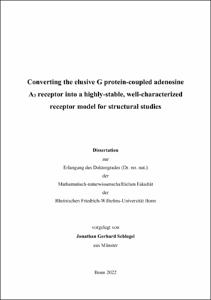Schlegel, Jonathan Gerhard: Converting the elusive G protein-coupled adenosine A3 receptor into a highly-stable, well-characterized receptor model for structural studies. - Bonn, 2023. - Dissertation, Rheinische Friedrich-Wilhelms-Universität Bonn.
Online-Ausgabe in bonndoc: https://nbn-resolving.org/urn:nbn:de:hbz:5-70056
Online-Ausgabe in bonndoc: https://nbn-resolving.org/urn:nbn:de:hbz:5-70056
@phdthesis{handle:20.500.11811/10664,
urn: https://nbn-resolving.org/urn:nbn:de:hbz:5-70056,
author = {{Jonathan Gerhard Schlegel}},
title = {Converting the elusive G protein-coupled adenosine A3 receptor into a highly-stable, well-characterized receptor model for structural studies},
school = {Rheinische Friedrich-Wilhelms-Universität Bonn},
year = 2023,
month = mar,
note = {The G protein-coupled adenosine A3 receptor (A3AR) is widely expressed in the human body, with the highest expression levels found in lung and liver. The receptor is involved in a number of pathological processes, e.g., in various cancer types, where it is upregulated, in inflammatory and immune processes, and in the modulation of pain. Several clinical studies have been or are currently being conducted to explore the receptor’s potential as a drug target for the treatment of a variety of diseases including psoriasis, ulcerative colitis, rheumatoid arthritis, and hepatocellular carcinoma.
The extremely time-consuming and challenging process of drug development can be facilitated and supported by structural biology, which helps to understand a drug target and its interactions on a molecular level. Despite tremendous progress in this field, the structures of only around 20 % of all presumably druggable G protein-coupled receptors (GPCRs) have been determined, demonstrating that structure determination of GPCRs, in particular by X-ray crystallography remains ambitious. In the family of adenosine receptors, the A1AR and the A2AAR, which serves as a prototypical rhodopsin-like GPCR, were successfully crystallized, and high-resolution structures were obtained. In contrast, research on the A3AR is less advanced, and no A3AR structure nor any progress towards the elucidation of its structure has been published so far.
This thesis describes the procedure of preparing a so far elusive GPCR for structural studies. Once removed from their native membrane environment, the resulting inherent instability of GPCRs impairs their investigation. Initial A3AR constructs showed extremely low stability, which prohibited their suitability for crystallization. However, the instability of the A3AR could eventually be overcome by stepwise optimization, and receptor constructs with high stability were developed, comparable to that of published and crystallized constructs of other GPCRs. A3AR-specific features, such as the role of N-glycosylation sites, were explored, contributing to the characterization of the A3AR. Comprehensive validation of the novel A3AR constructs revealed altered binding properties when expressed in insect cell membranes as compared to mammalian cell membranes. This indicates that the A3AR and its ligand binding are dependent on a specific membrane environment. Understanding of the underlying mechanisms will be important to understand binding and signalling of the A3AR and probably of other GPCRs as well. Altogether, the results of the present thesis will essentially contribute to the structure elucidation of the A3AR. The new findings regarding ligand binding of the A3AR may be of general importance in the field of GPCR pharmacology and structural biology.},
url = {https://hdl.handle.net/20.500.11811/10664}
}
urn: https://nbn-resolving.org/urn:nbn:de:hbz:5-70056,
author = {{Jonathan Gerhard Schlegel}},
title = {Converting the elusive G protein-coupled adenosine A3 receptor into a highly-stable, well-characterized receptor model for structural studies},
school = {Rheinische Friedrich-Wilhelms-Universität Bonn},
year = 2023,
month = mar,
note = {The G protein-coupled adenosine A3 receptor (A3AR) is widely expressed in the human body, with the highest expression levels found in lung and liver. The receptor is involved in a number of pathological processes, e.g., in various cancer types, where it is upregulated, in inflammatory and immune processes, and in the modulation of pain. Several clinical studies have been or are currently being conducted to explore the receptor’s potential as a drug target for the treatment of a variety of diseases including psoriasis, ulcerative colitis, rheumatoid arthritis, and hepatocellular carcinoma.
The extremely time-consuming and challenging process of drug development can be facilitated and supported by structural biology, which helps to understand a drug target and its interactions on a molecular level. Despite tremendous progress in this field, the structures of only around 20 % of all presumably druggable G protein-coupled receptors (GPCRs) have been determined, demonstrating that structure determination of GPCRs, in particular by X-ray crystallography remains ambitious. In the family of adenosine receptors, the A1AR and the A2AAR, which serves as a prototypical rhodopsin-like GPCR, were successfully crystallized, and high-resolution structures were obtained. In contrast, research on the A3AR is less advanced, and no A3AR structure nor any progress towards the elucidation of its structure has been published so far.
This thesis describes the procedure of preparing a so far elusive GPCR for structural studies. Once removed from their native membrane environment, the resulting inherent instability of GPCRs impairs their investigation. Initial A3AR constructs showed extremely low stability, which prohibited their suitability for crystallization. However, the instability of the A3AR could eventually be overcome by stepwise optimization, and receptor constructs with high stability were developed, comparable to that of published and crystallized constructs of other GPCRs. A3AR-specific features, such as the role of N-glycosylation sites, were explored, contributing to the characterization of the A3AR. Comprehensive validation of the novel A3AR constructs revealed altered binding properties when expressed in insect cell membranes as compared to mammalian cell membranes. This indicates that the A3AR and its ligand binding are dependent on a specific membrane environment. Understanding of the underlying mechanisms will be important to understand binding and signalling of the A3AR and probably of other GPCRs as well. Altogether, the results of the present thesis will essentially contribute to the structure elucidation of the A3AR. The new findings regarding ligand binding of the A3AR may be of general importance in the field of GPCR pharmacology and structural biology.},
url = {https://hdl.handle.net/20.500.11811/10664}
}






